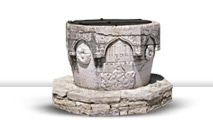
- Sečovlje Salt Pans - Dragonja River Valley
- Sv. Peter - Nova vas - Padna
- Pomjan - Nature Park: Karst Edge - Socerb
- Črni Kal - Osp - Kubed
- Momjan - Grožnjan - Pietrapelosa - Mirna
- Baštija - Kostanjica - Parenzana
- Oprtalj - Završje - Livade - Zrenj
- Istarske toplice - Motovun Forest - Višnjan
- Cave Mramornica - Feštini Kingdom - Cave Baredine
- Lim Bay - Kloštar - Kontija - Dvigrad
- Kanfanar - Bale - Palud - Vodnjan -Islands Brijuni - Fažana
- Svetvinčenat - Tinjan - Pićan - Gračišće
- Belaj - Šumber - Kožljak - Paz
- Čepićko Field - Kršan - Boljun Castle - Lupoglav
- Plomin - Kvarner Gulf - Brseč
- Nature park Učka - Mošćenice
Oprtalj - Završje - Livade - Zrenj
Zrenj
A small and modest town near Oprtalj was once swarming with skillful and wealthy craftsmen – blacksmiths, weavers and stone masons. The area was inhabited already in prehistory and was mentioned in the 11th c. From the 14th c. it became part of the Pietrapelosa property, and later belonged to the Gravisi family. In the 16th c. it was inhabited by refugee families from Dalmatia who fled before the Osmanlis.
The architecture of the town is well preserved and bears rural traits, known for the consistence in covering the roofs with stone slates (škrile). Also named Stridone, Zrenj is considered the birthplace of St. Jerome, although the identification is not reliable. The parish church is dedicated to St. George and was built in the Romanesque style. Charming Zrenj is one of the glittering, lively pieces of the mosaic of one-time Istria.
Print page Send to a friend














